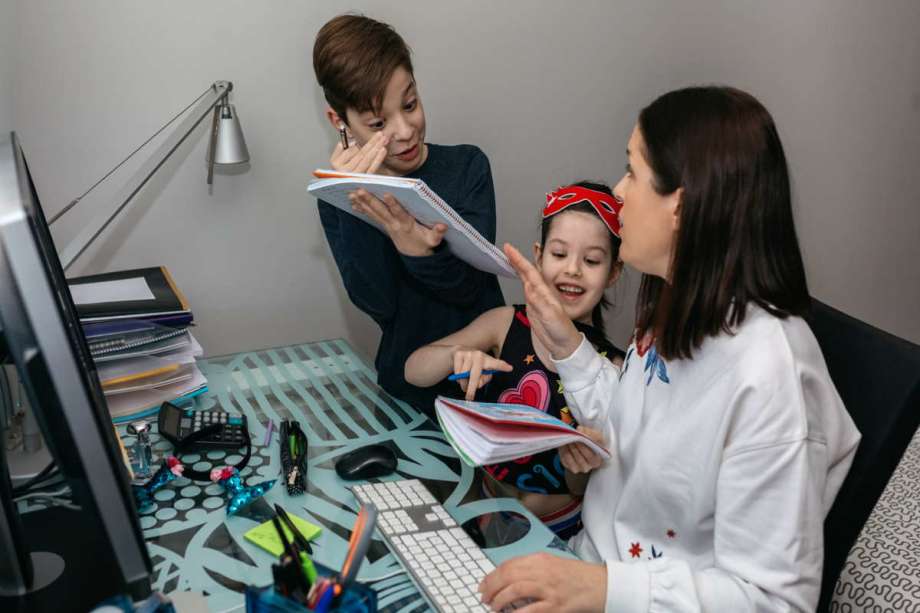How to Make Homeschooling Less Stressful

Homeschooling can be stressful for the entire family, but it doesn’t have to be. Now that schools in many states have shut down, parents all over the nation have become their children’s teachers and many have never done anything like this before. Diving into something new and unfamiliar is bound to cause some level of anxiety, but there are a few things parents can do to make crisis homeschooling less straining on everyone in the family.
More: Helping Kids Deal With Anxiety Related to the Coronavirus
Pin it to save for later:
Bookmark Your State’s Standards
Look up the standards that your state has adopted and find your children’s grade levels. Most states have adopted the Common Core for math and language. Familiarize yourself with the standards and write down the ones you are working on somewhere where you can see it. Post-its are great for this.
Instead of getting overwhelmed with the specifics of lesson planning or wondering if your kid is doing their work “right,” keep things simple and focus on helping them to master each standard. That’s really the end goal, and there is no need to complicate it.
Don’t forget to share the standards with your children. Rewrite them in kid friendly language and tell your students that this is their objective. It will make a huge difference!
Find Good Resources and Use Them
You do not have to reinvent the wheel. There are so many helpful resources on the internet that you can use to help you homeschool your children. Even if their classroom teacher is sending work, it is still helpful to have something else to supplement their assignments with.
Find a few trustworthy resources that you can continue to utilize as you homeschool. We offer a daily newsletter with everything you need to adapt and adjust to parenting and teaching at home called the Prepared Parent. Each day our team of experts will bring you a rundown of everything you need to teach the kids, stay sane, and maybe even thrive during this challenging time.
Sign up for the Prepared Parent here.
Our sister sites TeacherVision and Fact Monster also provide a huge variety of curriculum and homework help resources for homeschooling. TeacherVision has made all of its resources freely available to teachers and parents - the complete collection includes over 22,000 resources created by experienced teachers and industry experts including education publishers and licensed education professionals. Fact Monster features kid-friendly games, quizzes, and all the facts and information they'll ever need for research or homework help.
Stick to a Schedule
Create a routine that works for your family. Consider the whole day, including meal times, time for active play, and downtime. Make sure to include 30 minutes of independent reading time, time for you to give lessons, and time for your children to work on their assignments.
Post your final schedule where everyone in your family can refer to it, and stick to it. Keeping to the program might seem excessive at first, but the truth is, it will reduce everyone’s stress. You may be surprised at how quickly your children adjust to the new plan. Routine is comforting to everyone, especially kids.
Homeschooling Only Takes About Two Hours Per Day
Before the coronavirus shutdown, in reality your kids spent six hours each day in school. But that does not mean that you need to devote an equal amount of time to teaching them at home. Homeschool is totally different from traditional school, and it does not take as long!
Consider that while your kids are at school, they are doing things like circle time, recess, library visits, art class, and physical education. Academics only take up about half of their day, and even then, the process of teaching a lesson to a full class of children takes longer than teaching one to one.
According to the Illinois State Board of Education’s remote learning recommendations, created specifically to address what virtual education should look like during the COVID-19 emergency, a kindergartener should spend about an hour on homeschool, a fourth grader should spend one to two hours, and a middle-schooler should spend about three hours. Homeschooling gives you a chance to really focus on quality over quantity.
At the end of the day, go easy on yourself. Just the fact that you have been able to make this attempt is huge. We are all in this together, and we will get through this! Keep trying your best and using strategies to make homeschooling less stressful for everyone. These are unprecedented times and the greatest gift you can give your children is a sense of peace and tranquility.
Struggling with the upcoming school year? Check out How to Talk to Your Kids About the Upcoming School Year for tips and advice from a veteran teacher and parent.

